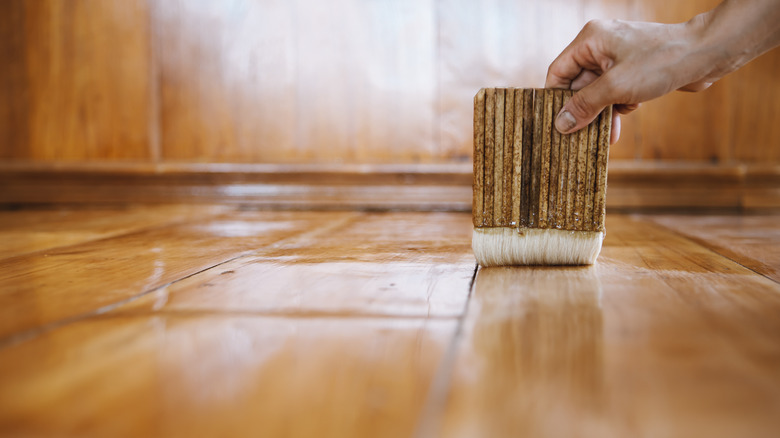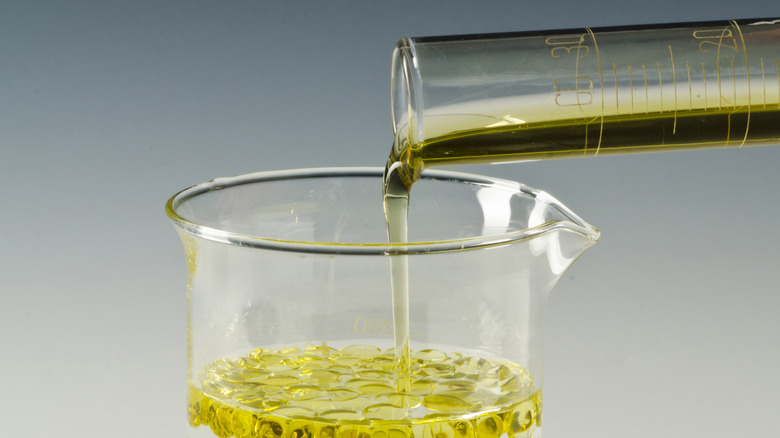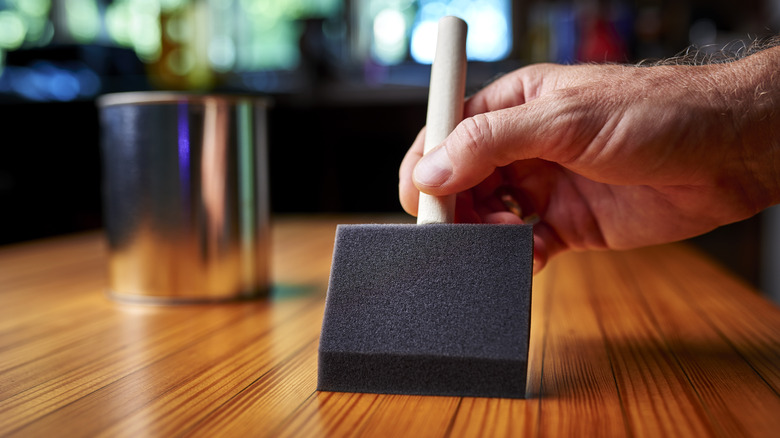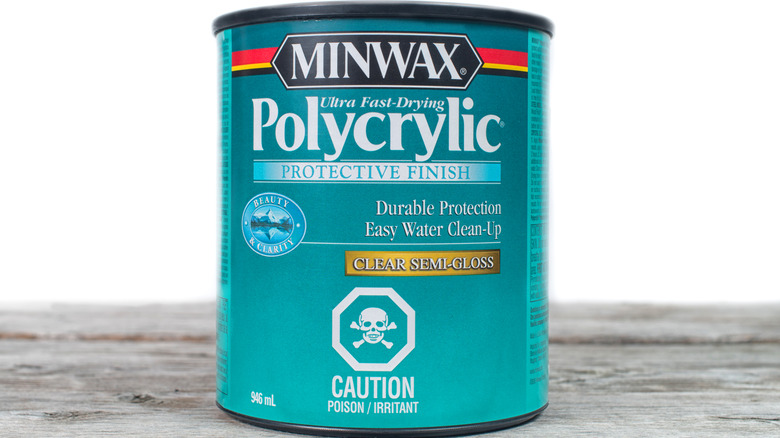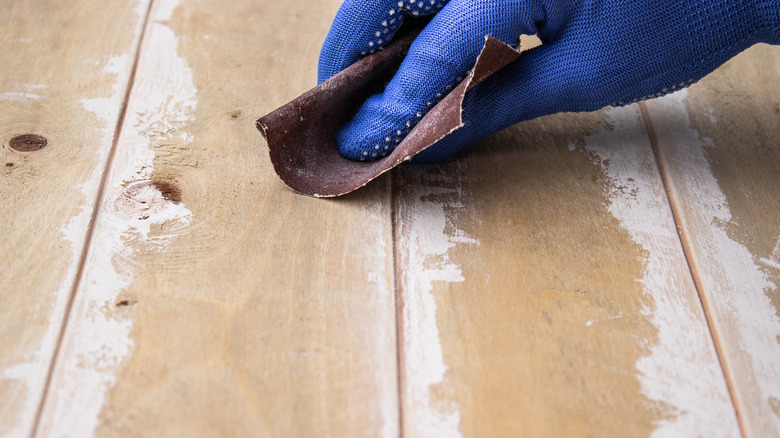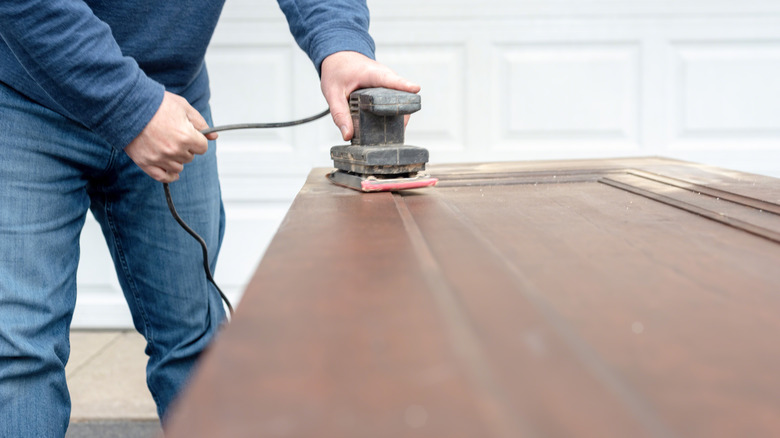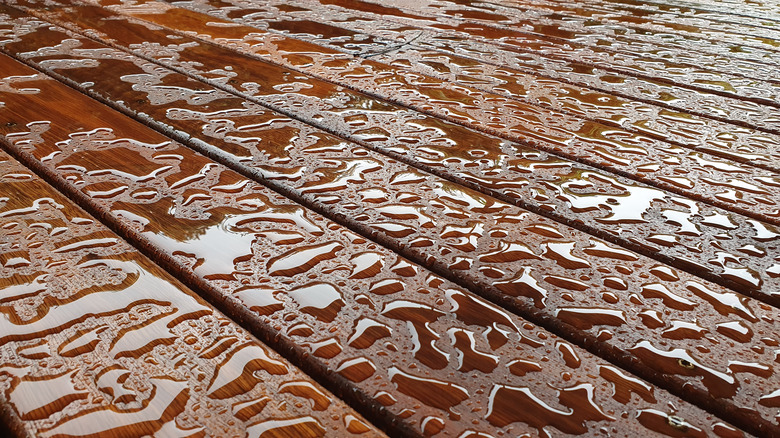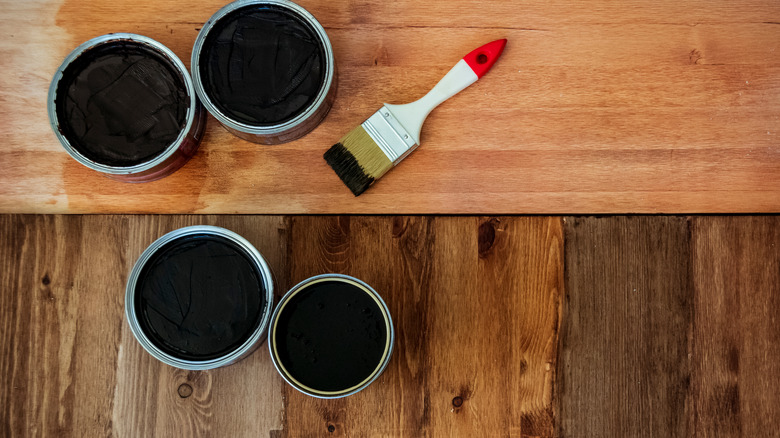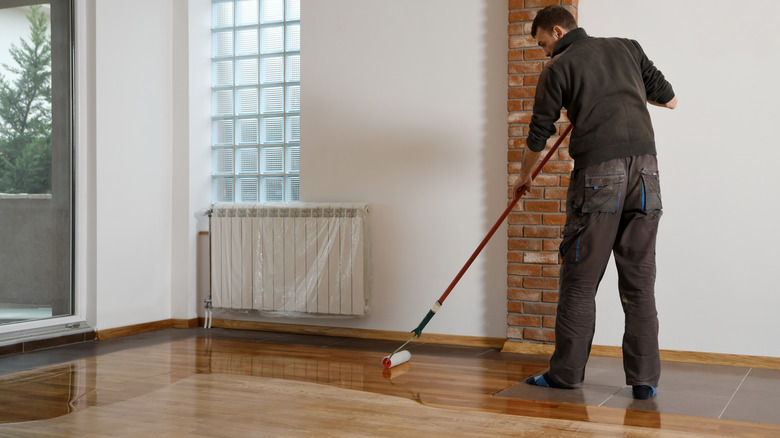Polycrylic Vs Polyurethane: What's The Difference?
Clear protective finishes are a natural choice for just about anything you want to keep around for a while... especially expensive items like floors and furniture that are susceptible to damage from water and other forces. For this reason, polyurethane has become something of a standard finish for many purposes. Oil-based polyurethane, however, has some distinct drawbacks that are alleviated, to some extent, by water-based polyurethanes and their younger cousin, Polycrylic.
To get a handle on why you'd have three such products, it helps to understand the finish landscape. John Cesaro of Lincoln St. Woodworks divides it like this: finishes can be grouped into natural oils like tung and linseed, hardwax oils like Rubio Monocoat, and varnishes, a big category that includes everything else. Oil-based polyurethane, Polycrylic, and other water-based polyurethanes are varnishes. When you compare the key characteristics of all of them, a picture emerges of polyurethane as a middle-of-the-pack product with a single advantage in terms of its protective properties, offset by some distinct disadvantages like the plastic-like appearance (via Rubio Monocoat). This appearance is well-earned, since oil-based polyurethane is essentially a plastic coating. And while it's certainly durable and protective, plastic isn't what everyone is going for in a wood finish.
Polycrylic and water-based polyurethane entered the fray with some new properties to compete against the oil finishes. It dries faster — a distinct advantage in a marketplace dominated by excruciatingly long dry and cure times. And it looks more natural than oil-based polyurethane... maybe.
There's understandably some confusion among consumers about the differences between oil- and water-based polyurethane and Polycrylic. Let's take a look.
How does the composition differ?
Polycrylic and polyurethane are both clear varnishes, and if the "poly" makes them sound similar, that's no accident. Polycrylic is usually described as a proprietary formulation of polyurethane with acrylic elements added, according to Woodworking Clarity, and is a Minwax trademark. Think of it like this: polyurethane is ketchup, and Polycrylic is sriracha ketchup. It's still ketchup, but wow is it not ketchup at all. As a subset of water-based polyurethanes (an acrylic base with polyurethane added), Polycrylic shares a lot of their composition and characteristics and we'll mostly use them interchangeably here.
In terms of what's in the can, Polycrylic is water-based with acrylic and polyurethane elements, as we've said. It has much lower VOC content, and as such its manufacturers are somewhat future-proofed against anti-VOC regulation (via American Chemistry). Oil-based polyurethane, on the other hand, consists of polyurethane solids dissolved in petroleum or mineral solvents.
We'll touch on more specifics about their contents when we discuss safety issues.
How does the appearance differ?
Appearance, of course, is where the rubber meets the road... or, in this case, where the plastic meets the wood, when it comes to wood finishes. Both polyurethane and Polycrylic are mostly clear topcoats, but how they work on light and darker woods (or stains) can be dramatically different.
Oil-based polyurethane typically has a slight amber tint, which can sometimes show up slightly when very light woods are coated with water-based polyurethane. Polycrylic is generally more clear and doesn't impart that amber tone, says Woodworking Clarity. But there could be a price to pay, depending on your preferences. The clarity of Polycrylic can contribute, at least for some, to the plastic appearance that many object to, while the amber tint lessens the effect. Since both sit on top of the wood rather than absorbing into it, it is difficult to avoid this plastic look with any polyurethane varnish (via Saws On Skates).
When used on darker woods, or woods with a darker stain or other finish, Polycrylic (and water-based polyurethane) can take on an opaque appearance over darker woods and finishes, often described as "cloudy" or "milky." Overall, water-based polyurethane has its detractors. Jon Cesaro pulls no punches: "The Polycrylic is simply horrible. Everything about it looks fake." He goes on to argue that it gives an amber cast to maple, which undermines the point of water-based poly to begin with (via Lincoln St. Woodworks).
What are the differences in cost?
Polycrylic is quite a bit more expensive than polyurethane. Just to keep things level, we compared the cost of a quart of Polycrylic and a quart of Minwax polyurethane at Lowe's. Polycrylic rings up at $23.98, while a quart of polyurethane is $15.98. Prices are similar at Home Depot, where the average of the clear oil-based polyurethanes in stock locally was $17.48 per quart (excluding Varathane pour-on epoxies, which Home Depot categorizes as polyurethane).
But since Polycrylic requires a minimum of three coats (versus two for polyurethane), Polycrylic ends up costing about 2.25 times as much to apply. Since the difference is magnified with each additional coat, it's worth noting that many recommend more coats. For example, Woodsmith Spirit, who tends to be a fan of Polycrylic used in the right circumstances, suggests at least 2 coats of polyurethane and a minimum of five coats of Polycrylic. That's over 3.75 times the cost of using Polycrylic instead of oil-based polyurethane.
For what it's worth, Home Depot does offer two water-based polyurethanes that are cheaper than Polycrylic, coming in at $17.48 and $19.97 per quart.
Does Polycrylic have fewer VOCs than polyurethane?
While safe-handling instructions are similar for both products, polyurethane is definitely more hazardous overall, at least in the short term. This is mostly a function of the greater concentration of volatile organic compounds that off-gas from the finish after it's been applied. Comparing just Minwax products, we see that Polycrylic contains a maximum of 275 g/L of VOCs. This also holds for the company's One Coat Polyurethane, which isn't specifically mentioned as a water-based product but clearly is, given the recommended soap-and-water cleanup. Minwax/s oil-based polyurethanes, on the other hand, range in VOC content from 350 g/L for one Fast-Drying Polyurethane to 450 g/L for a different Fast-Drying Polyurethane to 600 g/L in their Wipe-On Poly Oil-Based Polyurethane Finish
The website Minwax does not give VOC ratings for its Polycrylic aerosol. Unlike all its other polyurethane products, the Technical Data Sheet (for some, Product Data Sheet) does not include this number. Many vendors use the same 275 g/L figure as for Polycrylic brush-on liquid, but given that most chemicals in aerosols are VOCs this is unlikely to be true. Green Seal recommends avoiding aerosols altogether if you want to reduce your exposure to VOCs.
There's a fly in the ointment, though: the EPA states clearly that only chemicals that contribute to creating ozone are factored into their VOC regulations. So a product could contain high levels of extremely toxic VOCs and still be labeled "no VOC" or "low VOC," so long as the VOCs in question don't contribute to smog. And while none of the products we examined come close to meeting the 50 g/L requirement for a "low VOC" label, note that the EPA also says that total VOC figures aren't necessarily helpful because some VOCs are far more toxic than others, a distinction ignored by the labeling requirements.
Is Polycrylic safer than polyurethane?
As if all this weren't bewildering enough, other safety issues are just as opaque. Clearly, Polycrylic is at least a little safer than oil-based polyurethane with regard to VOC content. In terms of non-VOC safety factors, unpuzzling safety data sheets is virtually impossible. For example, the potential acute health effects section of the SDS for Minwax Polycrylic Ultra Flat indicates that there are "no known significant effects or critical hazards" for eye contact, inhalation, skin contact, and ingestion. But the preceding page instructs that you get medical help regardless of symptoms for all of these except eye contact. Meanwhile, further down in the "toxological information" section we learn that acute toxicity has been observed in rats and rabbits for three of the ingredients.
However you interpret it, the SDS for oil-based polyurethane tends to be worse. While Polycrylic clear semi-gloss has two protective statements related to unborn children and repeated exposure, the Fast-Drying Polyurethane Clear Gloss data sheet lists seven ranging from drowsiness to fire to death (from ingestion).
The Environmental Working Group offers some general guidance for selecting a finish: choose a finish with less than 350 g/L of VOCs; avoid petroleum- and chemical-based solvents; choose durable finishes to reduce repeat exposure to toxic chemicals; look for Green Seal-11 certification; look for water-based finishes; and steer clear of N-methypyrrolidone, which causes reproductive harm. At a glance, all this would seem to recommend Polycrylic over oil-based polyurethane, but note that Polycrylic's lack of durability will contribute to repeated exposure through reapplication, and it does contain N-methypyrrolidone.
It's a good idea to follow the EWG suggestions and, if you can't, carefully follow the manufacturer's safe-use recommendations (including avoidance of both products if you're expecting). Ultimately, Polycrylic is the safer product, though not by nearly the margin you'd expect from what's been claimed by and written about them.
How easy is Polycrylic to DIY?
Both Polycrylic and polyurethane have similar and fairly strict instructions for application, but one characteristic makes Polycrylic both easier and more difficult to deal with as a DIYer. Its fast-drying nature means that you can get the job done quicker. But it also means that getting the job done can be extremely difficult if the workpiece or area is too large to allow for proper application before the finish dries. Since you shouldn't coat floors with Polycrylic, this probably isn't a major concern, but it's worth noting.
The process for using Polycrylic is straightforward, based on the product data sheet from Minwax. The company recommends a system including a pre-stain conditioner, and a stain if desired. To apply Polycrylic, store new wood indoors for 24 hours or more to acclimate. Remove old or unstable finishes and clean the workpiece of any dirt, grease, wax, and polish. Make sure the surface is dry before you begin.
Sand until you have a smooth, level surface. Finishes can pool in low spots, and it's practically impossible to correct this when polyurethane is involved. Stain if desired, following label recommendations about drying time before top-coating. Stir well before and periodically during the application of Polycrylic. Apply a thin coat with a loaded brush, brushing slowly with the grain, in one direction, and only once. After two hours, sand with 220 grit sandpaper (never steel wool), then clean away all dust from the sanding process. Apply a second coat, and subsequent coats if you desire, sanding and cleaning between each. Leave the piece untouched for three hours after the final application, and then only handle it lightly. You can resume normal use after 24 hours.
How easy Is polyurethane to DIY?
Minwax instructions for applying polyurethane are mostly the same, with some differences in timing, of course. Remove old finishes in disrepair, clean, dry, sand, remove dust, and stir frequently to avoid settling. The company emphasizes that polyurethane should be stirred and not shaken, siding with The West Wing's president Bartlet over James Bond, probably to minimize bubbles, which will ruin a polyurethane finish. Apply a thin coat using slow single strokes in one direction. After 3-4 hours, sand and clean, and repeat for each subsequent coat if you want more than two. The workpiece or area should remain unused for 24 hours before light use resumes.
Minwax does add some special instructions for floors, which don't apply to Polycrylic. Maintain a wet edge on each "row" of the finish to avoid visible marks, and use three coats. Resume walking on the floor after 72 hours. Replace furniture carefully after 72 hours as well, but wait seven days before placing rugs on the floor.
So which is easier? If you factor in drying times, Polycrylic is the clear winner here. A day-long process that makes entire rooms unavailable is painful enough; a week-long process is far worse. And since the polyurethane's VOC content probably means sealing off the room until the floor is very dry, this could amount to quite an inconvenience. You have to avoid dripping with both, though it might be more obvious and therefore more critical with oil-based poly.
Some general tips that apply to both types of finish: Avoid trying to re-work wet finish; the next coat will probably fix whatever you're wanting to fix. Use a high-quality, large, soft-bristled brush. Keep your brushes from drying out between coats. Don't ever use old finish, and buy small cans so you're not tempted to store it. For faster drying, apply thin coats and avoid humid days (via Semigloss Design).
Durability and maintenance
The durability of a protective finish obviously relates to the durability of the finished item, so it's hard to overstate its importance. And polyurethane wins hands-down when it comes to durability. In one of the best articles for which there can't be much of an audience, Woodshop News tells you clearly and thoroughly how to test finishes for resistance to scratches, water, heat, and chemicals, as well as adhesion. Not many non-professionals probably want to perform such tests themselves, but the piece does make some interesting generalizations about durability.
Oil-based polyurethane is more scratch resistant than water-based, including Polycrylic, and far more resistant than most other varnishes. In terms of heat resistance, oil-based polyurethane will handle it better than water-based finishes, shellac, and lacquer.
The resins in oil-based varnishes are far more durable than oil finishes themselves, and polyurethane is unequaled with regard to resisting heat, abrasions, and solvents. Water-based polyurethane is quite scratch-resistant, but lacks the heat and solvent resistance of the oil-based versions (via Fine Woodworking).
Pros and cons of polycrylic and polyurethane
At a glance, Polycrylic is a clear, fast-drying, somewhat safer protective finish. It has some significant downsides in terms of difficulty of application and durability.
Pros of Polycrylic include reasonably strong scratch resistance, less yellowing than oil-based polyurethane, easy cleanup with soap and water, and low odor. It has significantly lower VOCs than oil-based poly and isn't flammable. It has a two-hour recoating dry time (via Saws On Skates).
The downsides of Polycrylic are its relatively weak water resistance, its cloudy appearance on dark woods or finishes, and minor yellowing when used on some light woods. Polycrylic is relatively expensive.
Polyurethane is a durable clear topcoat perfect for many uses. But it is time-consuming to use, and its thick application and clarity contribute to a plastic look that isn't welcome on all finished products, such as fine furniture. Pros include its extreme durability in every regard, and comparatively low cost (via WoodWorkly).
Polyurethane cons include a sometimes plasticky look, long dry times, and a high VOC rating.
Recommended uses of Polycrylic and polyurethane
Polycrylic is a better choice for interior woodwork and furniture, according to Minwax, except where the treated item will get a lot of wear. It's also more suitable for small pieces that can receive a coat during its relatively short dry time, and for those with constricted timeframes. You'll like the look better on lighter woods. If you're confined to a closed space, Polycrylic will smell better and release fewer VOCs into your immediate environment.
Polyurethane is better for areas that are exposed to heat or water, and has superior UV protection as well. and for items and areas that receive a lot of wear, like tabletops and floors. If you're covering a lot of area, polyurethane is a better bet most of the time. And while water-based polyurethane has improved a lot in recent years, oil-based polyurethane is still a better bet for use outside. Use oil-based poly on darker woods (via Minwax).
